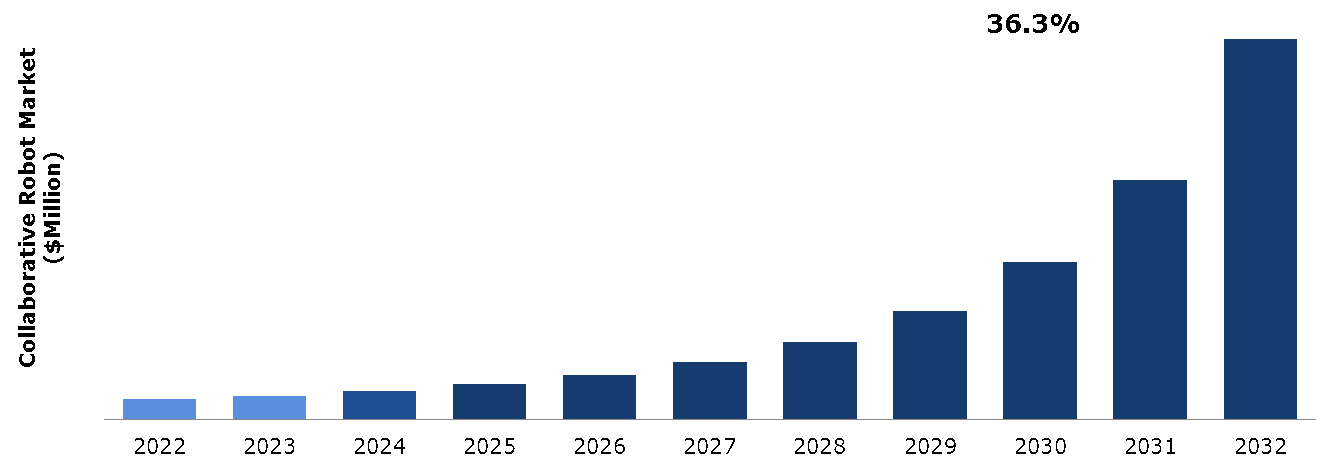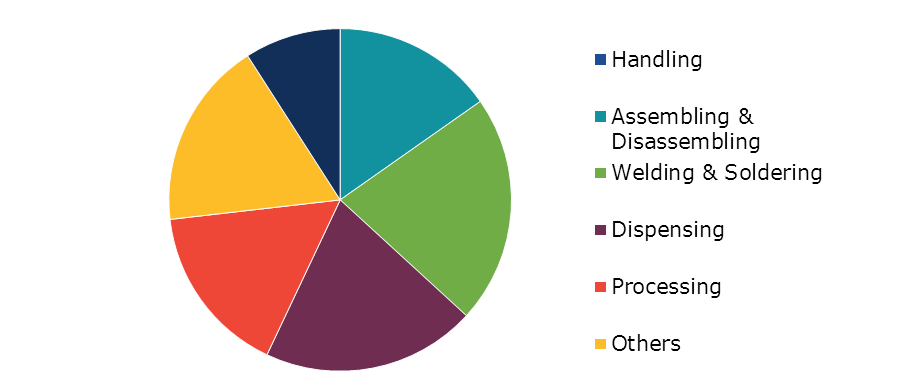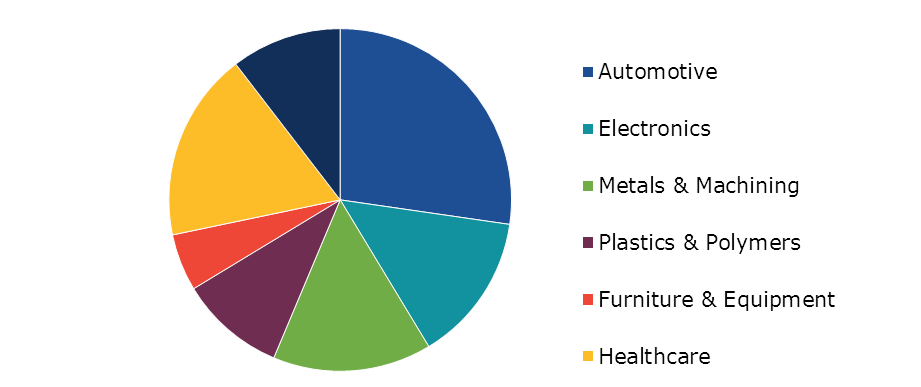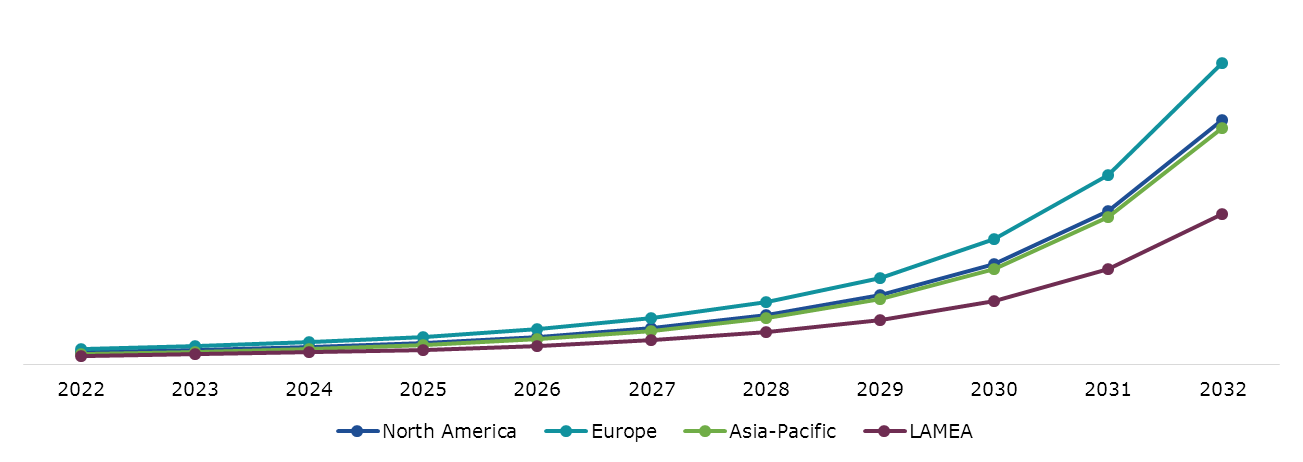Global Collaborative Robot Market Report
RA00182
Global Collaborative Robot Market by Component (Hardware and Software), Application (Handling, Assembling & Disassembling, Welding & Soldering, Dispensing, Processing, and Others), End User (Automotive, Electronics, Metals & Machining, Plastics & Polymers, Furniture & Equipment, Healthcare, and Others), Payload Capacity (Up to 5Kg, Up to 10Kg, and Above 10Kg), and Region (North America, Europe, Asia-Pacific, and LAMEA): Opportunity Analysis and Industry Forecast, 2023-2032
Collaborative Robot Overview
Collaborative robots, often referred to as cobots, are a type of robotic system designed to work alongside humans in a shared workspace. Unlike traditional industrial robots that are typically operated in isolation or under safety barriers, cobots are designed to be safe and interactive, allowing for close collaboration between humans and robots. Cobots are equipped with various safety features, such as force and torque sensors, vision systems, and proximity sensors, to detect and respond to human presence. They are designed to stop or slow down their movements if they detect any unexpected contact with humans.
Cobots are intended to work in close proximity to humans, sharing the same workspace. They are designed to assist humans in tasks that require physical strength, precision, or repetitive actions. Cobots can take over daily or strenuous tasks, allowing human operators to focus on more complex or cognitive aspects of the job. Collaborative robots are designed to be user-friendly and easily programmable, even by non-experts. Some cobots also support offline programming, where the robot's actions can be simulated and programmed on a computer before deployment. Cobots are typically lightweight and compact, making them highly flexible and easy to integrate into existing work environments. They can be easily moved and reprogrammed to perform different tasks, making them suitable for small-batch production, agile manufacturing, and frequent task changes.
Global Collaborative Robot Market Analysis
The global collaborative robot market size was $1,430.00 million in 2022 and is predicted to grow with a CAGR of 36.3%, by generating a revenue of $27,380.00 million by 2032.
Source: Research Dive Analysis
COVID-19 Impact on Global Collaborative Robot Market
The COVID-19 pandemic has had a mixed impact on the collaborative robot market. The pandemic disrupted global supply chains and manufacturing operations, leading to a slowdown in the adoption of new technologies, including collaborative robots (cobots). Many businesses faced financial challenges and uncertainty, which caused them to delay or scale back their automation plans. The pandemic also highlighted the importance of automation and robotics in maintaining productivity and ensuring business continuity during crises. Cobots, with their ability to work alongside humans and perform repetitive or dangerous tasks, gained attention as a potential solution to address labor shortages and social distancing requirements in manufacturing and other industries.
There was an increase in demand for cobots in industries such as healthcare, pharmaceuticals, food processing, and logistics, which were considered essential during the pandemic. These robots helped with tasks like disinfection, material handling, and assembly, reducing the risk of human exposure and enhancing operational efficiency. Cobots were considered as an option to enhance domestic manufacturing capabilities and reduce reliance on overseas production, driving interest in automation technologies.
Rising Demand for Automation in Various Industries to Drive the Collaborative Robot Market Growth
The increasing demand for automation in various industries such as manufacturing, logistics, and healthcare is indeed a significant growth driver for the collaborative robot market. Collaborative robots are designed to work alongside humans in a cooperative manner, enabling them to share the same workspace safely and effectively. Collaborative robots can perform repetitive tasks with high accuracy and speed, leading to increased productivity in industries such as manufacturing. They can work continuously without fatigue or the need for breaks, which helps to optimize production processes and improve overall efficiency.
Furthermore, collaborative robots are designed to be flexible and easily reprogrammable, allowing them to perform various tasks without significant downtime. This versatility is particularly valuable in industries with changing production requirements or shorter product life cycles. Collaborative robots can be quickly reconfigured to handle new tasks or be moved to different workstations as needed. Collaborative robots enable humans and machines to work together more effectively, leading to increased productivity. By automating repetitive or dangerous tasks, cobots reduce the risk of human error and physical strain on workers. This not only improves worker safety but also allows employees to focus on more complex or value-added activities. The combination of safety and increased productivity makes collaborative robots an attractive solution for various industries. The emphasis on worker safety, compliance with safety regulations, accident prevention, increased efficiency, productivity gains, and cost-effectiveness are all important drivers that are projected to drive the growth of the collaborative robot market.
To know more about global collaborative robot market drivers, get in touch with our analysts here.
Safety Concerns and Technical Limitations to Restrain the Market Growth
Security and technical limitations are a major concern for users of collaborative robots, especially in the industrial and government sectors. Companies need to conduct thorough risk assessments to identify potential hazards associated with cobot operations. They must also ensure compliance with safety standards and regulations specific to their industry and region. Meeting these standards can be challenging, particularly for small and medium-sized enterprises (SMEs) with limited resources and expertise. Integrating cobots into existing workflows and ensuring compatibility with other equipment, tools, and systems can pose challenges. Companies may also encounter difficulties while implementing cobots in dynamic or unpredictable work environments. Furthermore, one of the key limitations of cobots is their limited payload capacity. Cobots are typically designed to work alongside humans and assist with tasks that require less strength. While they can handle lightweight objects efficiently, their ability to lift heavy or bulky items is often restricted. This can be a significant constraint in industries that involve heavy lifting or manipulation of large objects, which is anticipated to hamper the collaborative robot industry demand.
Increased Efficiency and Productivity to Create Significant Opportunities in the Collaborative Robot Market
The integration of collaborative robots into industrial operations provides a range of opportunities for increased efficiency and productivity. By automating repetitive tasks, improving safety, and working alongside human workers, cobots contribute to a more productive and optimized work environment. Cobots are equipped with advanced sensors and safety features that allow them to operate safely alongside humans without the need for safety barriers. These robots can detect the presence of humans and adjust their speed or stop entirely to avoid collisions or injuries. This enhanced safety allows for closer human-robot collaboration, reducing the risk of accidents and creating a safer working environment. Moreover, cobots are designed to be easily programmable and reprogrammable, allowing businesses to quickly adapt them to different tasks and production requirements. This flexibility enables efficient production line changes, batch production, and customization without lengthy reconfiguration processes. Companies can quickly retrain cobots for new tasks, reducing setup times and enhancing overall operational responsiveness. In addition, collaborative robots provide a cost-effective automation solution for SMEs. Unlike traditional industrial robots that require complex programming and safety measures, cobots are designed to be easily programmable, flexible, and safe to work alongside humans. This makes them accessible to smaller businesses that may have limited resources and expertise in automation.
To know more about global collaborative robot market opportunities, get in touch with our analysts here.
Global Collaborative Robot Market Size, by Component, 2022
Source: Research Dive Analysis
The hardware sub-segment accounted for the highest market share in 2022. The hardware components, such as robot arms, sensors, grippers, and control systems, are essential for enabling the collaborative capabilities of these robots. The continuous advancements in robot technology have led to the development of more sophisticated and capable hardware components for collaborative robots. Improved robot arms with greater precision, agility, and payload capacity, along with advanced sensors and vision systems, contribute to the overall performance and functionality of cobots. Collaborative robots offer a cost-effective and flexible solution for various industrial applications. Compared to traditional industrial robots, cobots are generally easier to program, set up, and operate. The hardware components are designed to be user-friendly, modular, and adaptable, allowing for quick deployment and reconfiguration to meet changing production needs. The cost-effectiveness and flexibility of cobots make them attractive to small and medium-sized enterprises (SMEs) that may have limited resources and production requirements.
Global Collaborative Robot Market Share, by Application, 2022
Source: Research Dive Analysis
The assembling & disassembling sub-segment accounted for the highest market share in 2022, owing to the increasing demand for automation solutions in manufacturing and industrial processes. Collaborative robots are designed with built-in safety features, such as force sensing, power and speed limitations, and collision detection. This allows them to work safely alongside human operators without the need for physical barriers. Assembling and disassembling tasks often require frequent changes in product configurations and setups. Collaborative robots can be easily reprogrammed and adapted to different tasks, allowing for greater flexibility in production lines. By automating assembling and disassembling processes, collaborative robots can significantly increase productivity and throughput. They can work continuously without fatigue, maintain consistent precision, and perform repetitive tasks with high accuracy, leading to improved efficiency and reduced cycle times.
Global Collaborative Robot Market Analysis, by End User, 2022
Source: Research Dive Analysis
The automotive sub-segment accounted for the highest market share in 2022. The automotive industry has a high demand for automation to enhance productivity, efficiency, and quality control in various manufacturing processes. Collaborative robots offer a flexible and cost-effective solution for automating repetitive tasks, such as assembly, pick & place, and material handling. Collaborative robots are equipped with advanced sensors and safety features, including force and proximity sensors, speed & torque limitations, and the ability to stop or slow down when a human enters their workspace. This enables human-robot collaboration, where cobots assist human workers rather than replacing them entirely. Automotive manufacturing often involves frequent changes in product design, production lines, and assembly processes. Collaborative robots excel in flexibility and adaptability, allowing easy reprogramming and reconfiguration for different tasks and setups. This agility is crucial in the dynamic automotive industry, where rapid prototyping and quick production line adjustments are common.
Global Collaborative Robot Market Growth, by Payload Capacity, 2022
Source: Research Dive Analysis
The up to 5kg sub-segment accounted for the highest market share in 2022. Collaborative robots in the up to 5kg payload range offer greater flexibility and adaptability compared to traditional industrial robots. They can be easily reprogrammed and redeployed for different tasks and applications, making them ideal for small and medium-sized enterprises (SMEs) with varying production needs. Furthermore, cobots in up to 5kg sub-segment are generally more affordable than larger industrial robots. The lower payload capacity reduces the complexity and cost of the robot system, making it more accessible to a wider range of industries and businesses. In addition, safety is a crucial aspect of collaborative robots. Cobots in up to 5kg payload range are engineered with advanced sensors and safety features, such as force-sensing technology and collaborative control modes. These features enable safe interaction between humans and robots without the need for extensive physical barriers or protective equipment, improving overall workplace safety and ergonomics.
Global Collaborative Robot Market Size & Forecast, by Region, 2022-2032 ($Million)
Source: Research Dive Analysis
The Europe collaborative robot market generated the highest revenue in 2022. Europe has been at the forefront of technological advancements in robotics and automation. The development of advanced sensors, artificial intelligence, and machine learning algorithms has enhanced the capabilities of collaborative robots, making them more adaptable and efficient. The concept of Industry 4.0, which focuses on the integration of automation and digital technologies in manufacturing, has gained significant traction in Europe. Collaborative robots play a crucial role in achieving flexible and interconnected production processes, enabling companies to optimize productivity, improve efficiency, and reduce costs. Many European countries have been experiencing labor shortages in certain industries. Collaborative robots offer a solution by automating repetitive and everyday tasks, allowing companies to address workforce gaps and increase productivity without compromising on quality. Governments in several European countries have implemented policies and initiatives to support the adoption of automation technologies, including collaborative robots. Financial incentives, tax benefits, and funding programs have encouraged companies to invest in these technologies, further driving the regional market growth.
Competitive Scenario in the Global Collaborative Robot Market
Investment and agreement are common strategies followed by major market players. For instance, in February 2021, ABB Group expanded its collaborative robot portfolio with the introduction of the SWIFTI and GoFa cobot range, delivering higher speeds and payloads. This new range complements ABB’s cobot line-up of YuMi and Single Arm YuMi and is faster, stronger, and more capable.
Source: Research Dive Analysis
Some of the leading collaborative robot market players are Universal Robots A/S, ABB, Fanuc Corporation, Denso Corporation, Techman Robot Inc., Omron Adept Technologies Inc., Doosan Robotics, Epson Robors, Robert Bosch GmbH, and F&P Robotics AG.
| Aspect | Particulars |
| Historical Market Estimations | 2020-2021 |
| Base Year for Market Estimation | 2022 |
| Forecast Timeline for Market Projection | 2023-2032 |
| Geographical Scope | North America, Europe, Asia-Pacific, and LAMEA |
| Segmentation by Component |
|
| Segmentation by Application |
|
|
Segmentation by End User
|
|
| Segmentation by Payload Capacity |
|
| Key Companies Profiled |
|
Q1. What is the size of the global collaborative robot market?
A. The size of the global collaborative robot market was over $1,430.0 million in 2022 and is projected to reach $27,380.0 million by 2032.
Q2. Which are the major companies in the collaborative robot market?
A. Universal Robots A/S and ABB are some of the key players in the global collaborative robot market.
Q3. Which region, among others, possesses greater investment opportunities in the future?
A. Asia-Pacific possesses great investment opportunities for investors in the future.
Q4. What will be the growth rate of the Asia-Pacific collaborative robot market?
A. Asia-Pacific collaborative robot market is anticipated to grow at 37.8% CAGR during the forecast period.
Q5. What are the strategies opted by the leading players in this market?
A. Agreement and investment are the two key strategies opted by the operating companies in this market.
Q6. Which companies are investing more on R&D practices?
A. Fanuc Corporation, Denso Corporation, and Techman Robot Inc., are the companies investing more on R&D activities for developing new products and technologies.
1.Research Methodology
1.1.Desk Research
1.2.Real time insights and validation
1.3.Forecast model
1.4.Assumptions and forecast parameters
1.5.Market size estimation
1.5.1.Top-down approach
1.5.2.Bottom-up approach
2.Report Scope
2.1.Market definition
2.2.Key objectives of the study
2.3.Report overview
2.4.Market segmentation
2.5.Overview of the impact of COVID-19 on Global collaborative robot market
3.Executive Summary
4.Market Overview
4.1.Introduction
4.2.Growth impact forces
4.2.1.Drivers
4.2.2.Restraints
4.2.3.Opportunities
4.3.Market value chain analysis
4.3.1.List of raw material suppliers
4.3.2.List of manufacturers
4.3.3.List of distributors
4.4.Innovation & sustainability matrices
4.4.1.Technology matrix
4.4.2.Regulatory matrix
4.5.Porter’s five forces analysis
4.5.1.Bargaining power of suppliers
4.5.2.Bargaining power of consumers
4.5.3.Threat of substitutes
4.5.4.Threat of new entrants
4.5.5.Competitive rivalry intensity
4.6.PESTLE analysis
4.6.1.Political
4.6.2.Economical
4.6.3.Social
4.6.4.Technological
4.6.5.Environmental
4.7.Impact of COVID-19 on collaborative robot market
4.7.1.Pre-covid market scenario
4.7.2.Post-covid market scenario
5.Collaborative Robot Market Analysis, by Component
5.1.Overview
5.2.Hardware
5.2.1.Definition, key trends, growth factors, and opportunities
5.2.2.Market size analysis, by region, 2022-2032
5.2.3.Market share analysis, by country, 2022-2032
5.3.Software
5.3.1.Definition, key trends, growth factors, and opportunities
5.3.2.Market size analysis, by region, 2022-2032
5.3.3.Market share analysis, by country, 2022-2032
5.4.Research Dive Exclusive Insights
5.4.1.Market attractiveness
5.4.2.Competition heatmap
6.Collaborative Robot Market Analysis, by Application
6.1.Handling
6.1.1.Definition, key trends, growth factors, and opportunities
6.1.2.Market size analysis, by region, 2022-2032
6.1.3.Market share analysis, by country, 2022-2032
6.2.Assembling & Disassembling
6.2.1.Definition, key trends, growth factors, and opportunities
6.2.2.Market size analysis, by region, 2022-2032
6.2.3.Market share analysis, by country, 2022-2032
6.3.Welding & Soldering
6.3.1.Definition, key trends, growth factors, and opportunities
6.3.2.Market size analysis, by region, 2022-2032
6.3.3.Market share analysis, by country, 2022-2032
6.4.Dispensing
6.4.1.Definition, key trends, growth factors, and opportunities
6.4.2.Market size analysis, by region, 2022-2032
6.4.3.Market share analysis, by country, 2022-2032
6.5.Processing
6.5.1.Definition, key trends, growth factors, and opportunities
6.5.2.Market size analysis, by region, 2022-2032
6.5.3.Market share analysis, by country, 2022-2032
6.6.Others
6.6.1.Definition, key trends, growth factors, and opportunities
6.6.2.Market size analysis, by region, 2022-2032
6.6.3.Market share analysis, by country, 2022-2032
6.7.Research Dive Exclusive Insights
6.7.1.Market attractiveness
6.7.2.Competition heatmap
7.Collaborative Robot Market Analysis, by End User
7.1.Automotive
7.1.1.Definition, key trends, growth factors, and opportunities
7.1.2.Market size analysis, by region, 2022-2032
7.1.3.Market share analysis, by country, 2022-2032
7.2.Electronics
7.2.1.Definition, key trends, growth factors, and opportunities
7.2.2.Market size analysis, by region, 2022-2032
7.2.3.Market share analysis, by country, 2022-2032
7.3.Metals & Machining
7.3.1.Definition, key trends, growth factors, and opportunities
7.3.2.Market size analysis, by region, 2022-2032
7.3.3.Market share analysis, by country, 2022-2032
7.4.Plastics & Polymers
7.4.1.Definition, key trends, growth factors, and opportunities
7.4.2.Market size analysis, by region, 2022-2032
7.4.3.Market share analysis, by country, 2022-2032
7.5.Furniture & Equipment
7.5.1.Definition, key trends, growth factors, and opportunities
7.5.2.Market size analysis, by region, 2022-2032
7.5.3.Market share analysis, by country, 2022-2032
7.6.Healthcare
7.6.1.Definition, key trends, growth factors, and opportunities
7.6.2.Market size analysis, by region, 2022-2032
7.6.3.Market share analysis, by country, 2022-2032
7.7.Others
7.7.1.Definition, key trends, growth factors, and opportunities
7.7.2.Market size analysis, by region, 2022-2032
7.7.3.Market share analysis, by country, 2022-2032
7.8.Research Dive Exclusive Insights
7.8.1.Market attractiveness
7.8.2.Competition heatmap
8.Collaborative Robot Market Analysis, by Payload Capacity
8.1.Up to 5Kg
8.1.1.Definition, key trends, growth factors, and opportunities
8.1.2.Market size analysis, by region, 2022-2032
8.1.3.Market share analysis, by country, 2022-2032
8.2.Up to 10Kg
8.2.1.Definition, key trends, growth factors, and opportunities
8.2.2.Market size analysis, by region, 2022-2032
8.2.3.Market share analysis, by country, 2022-2032
8.3.Above 10Kg
8.3.1.Definition, key trends, growth factors, and opportunities
8.3.2.Market size analysis, by region, 2022-2032
8.3.3.Market share analysis, by country, 2022-2032
8.4.Research Dive Exclusive Insights
8.4.1.Market attractiveness
8.4.2.Competition heatmap
9.Collaborative Robot Market, by Region
9.1.North America
9.1.1.U.S.
9.1.1.1.Market size analysis, by Component, 2022-2032
9.1.1.2.Market size analysis, by Application, 2022-2032
9.1.1.3.Market size analysis, by End User, 2022-2032
9.1.1.4.Market size analysis, by Payload Capacity, 2022-2032
9.1.2.Canada
9.1.2.1.Market size analysis, by Component, 2022-2032
9.1.2.2.Market size analysis, by Application, 2022-2032
9.1.2.3.Market size analysis, by End User, 2022-2032
9.1.2.4.Market size analysis, by Payload Capacity, 2022-2032
9.1.3.Mexico
9.1.3.1.Market size analysis, by Component, 2022-2032
9.1.3.2.Market size analysis, by Application, 2022-2032
9.1.3.3.Market size analysis, by End User, 2022-2032
9.1.3.4.Market size analysis, by Payload Capacity, 2022-2032
9.1.4.Research Dive Exclusive Insights
9.1.4.1.Market attractiveness
9.1.4.2.Competition heatmap
9.2.Europe
9.2.1.Germany
9.2.1.1.Market size analysis, by Component, 2022-2032
9.2.1.2.Market size analysis, by Application, 2022-2032
9.2.1.3.Market size analysis, by End User, 2022-2032
9.2.1.4.Market size analysis, by Payload Capacity, 2022-2032
9.2.2.UK
9.2.2.1.Market size analysis, by Component, 2022-2032
9.2.2.2.Market size analysis, by Application, 2022-2032
9.2.2.3.Market size analysis, by End User, 2022-2032
9.2.2.4.Market size analysis, by Payload Capacity, 2022-2032
9.2.3.France
9.2.3.1.Market size analysis, by Component, 2022-2032
9.2.3.2.Market size analysis, by Application, 2022-2032
9.2.3.3.Market size analysis, by End User, 2022-2032
9.2.3.4.Market size analysis, by Payload Capacity, 2022-2032
9.2.4.Spain
9.2.4.1.Market size analysis, by Component, 2022-2032
9.2.4.2.Market size analysis, by Application, 2022-2032
9.2.4.3.Market size analysis, by End User, 2022-2032
9.2.4.4.Market size analysis, by Payload Capacity, 2022-2032
9.2.5.Italy
9.2.5.1.Market size analysis, by Component, 2022-2032
9.2.5.2.Market size analysis, by Application, 2022-2032
9.2.5.3.Market size analysis, by End User, 2022-2032
9.2.5.4.Market size analysis, by Payload Capacity, 2022-2032
9.2.6.Rest of Europe
9.2.6.1.Market size analysis, by Component, 2022-2032
9.2.6.2.Market size analysis, by Application, 2022-2032
9.2.6.3.Market size analysis, by End User, 2022-2032
9.2.6.4.Market size analysis, by Payload Capacity, 2022-2032
9.2.7.Research Dive Exclusive Insights
9.2.7.1.Market attractiveness
9.2.7.2.Competition heatmap
9.3.Asia-Pacific
9.3.1.China
9.3.1.1.Market size analysis, by Component, 2022-2032
9.3.1.2.Market size analysis, by Application, 2022-2032
9.3.1.3.Market size analysis, by End User, 2022-2032
9.3.1.4.Market size analysis, by Payload Capacity, 2022-2032
9.3.2.Japan
9.3.2.1.Market size analysis, by Component, 2022-2032
9.3.2.2.Market size analysis, by Application, 2022-2032
9.3.2.3.Market size analysis, by End User, 2022-2032
9.3.2.4.Market size analysis, by Payload Capacity, 2022-2032
9.3.3.India
9.3.3.1.Market size analysis, by Component, 2022-2032
9.3.3.2.Market size analysis, by Application, 2022-2032
9.3.3.3.Market size analysis, by End User, 2022-2032
9.3.3.4.Market size analysis, by Payload Capacity, 2022-2032
9.3.4.Australia
9.3.4.1.Market size analysis, by Component, 2022-2032
9.3.4.2.Market size analysis, by Application, 2022-2032
9.3.4.3.Market size analysis, by End User, 2022-2032
9.3.4.4.Market size analysis, by Payload Capacity, 2022-2032
9.3.5.South Korea
9.3.5.1.Market size analysis, by Component, 2022-2032
9.3.5.2.Market size analysis, by Application, 2022-2032
9.3.5.3.Market size analysis, by End User, 2022-2032
9.3.5.4.Market size analysis, by Payload Capacity, 2022-2032
9.3.6.Rest of Asia-Pacific
9.3.6.1.Market size analysis, by Component, 2022-2032
9.3.6.2.Market size analysis, by Application, 2022-2032
9.3.6.3.Market size analysis, by End User, 2022-2032
9.3.6.4.Market size analysis, by Payload Capacity, 2022-2032
9.3.7.Research Dive Exclusive Insights
9.3.7.1.Market attractiveness
9.3.7.2.Competition heatmap
9.4.LAMEA
9.4.1.Brazil
9.4.1.1.Market size analysis, by Component, 2022-2032
9.4.1.2.Market size analysis, by Application, 2022-2032
9.4.1.3.Market size analysis, by End User, 2022-2032
9.4.1.4.Market size analysis, by Payload Capacity, 2022-2032
9.4.2.Saudi Arabia
9.4.2.1.Market size analysis, by Component, 2022-2032
9.4.2.2.Market size analysis, by Application, 2022-2032
9.4.2.3.Market size analysis, by End User, 2022-2032
9.4.2.4.Market size analysis, by Payload Capacity, 2022-2032
9.4.3.UAE
9.4.3.1.Market size analysis, by Component, 2022-2032
9.4.3.2.Market size analysis, by Application, 2022-2032
9.4.3.3.Market size analysis, by End User, 2022-2032
9.4.3.4.Market size analysis, by Payload Capacity, 2022-2032
9.4.4.South Africa
9.4.4.1.Market size analysis, by Component, 2022-2032
9.4.4.2.Market size analysis, by Application, 2022-2032
9.4.4.3.Market size analysis, by End User, 2022-2032
9.4.4.4.Market size analysis, by Payload Capacity, 2022-2032
9.4.5.Rest of LAMEA
9.4.5.1.Market size analysis, by Component, 2022-2032
9.4.5.2.Market size analysis, by Application, 2022-2032
9.4.5.3.Market size analysis, by End User, 2022-2032
9.4.5.4.Market size analysis, by Payload Capacity, 2022-2032
9.4.6.Research Dive Exclusive Insights
9.4.6.1.Market attractiveness
9.4.6.2.Competition heatmap
10.Competitive Landscape
10.1.Top winning strategies, 2022
10.1.1.By strategy
10.1.2.By year
10.2.Strategic overview
10.3.Market share analysis, 2022
11.Company Profiles
11.1.Universal Robots A/S
11.1.1.Overview
11.1.2.Business segments
11.1.3.Product portfolio
11.1.4.Financial performance
11.1.5.Recent developments
11.1.6.SWOT analysis
11.2.ABB
11.2.1.Overview
11.2.2.Business segments
11.2.3.Product portfolio
11.2.4.Financial performance
11.2.5.Recent developments
11.2.6.SWOT analysis
11.3.Fanuc Corporation
11.3.1.Overview
11.3.2.Business segments
11.3.3.Product portfolio
11.3.4.Financial performance
11.3.5.Recent developments
11.3.6.SWOT analysis
11.4.Denso Corporation
11.4.1.Overview
11.4.2.Business segments
11.4.3.Product portfolio
11.4.4.Financial performance
11.4.5.Recent developments
11.4.6.SWOT analysis
11.5.Techman Robot Inc.
11.5.1.Overview
11.5.2.Business segments
11.5.3.Product portfolio
11.5.4.Financial performance
11.5.5.Recent developments
11.5.6.SWOT analysis
11.6.Omron Adept Technologies Inc.
11.6.1.Overview
11.6.2.Business segments
11.6.3.Product portfolio
11.6.4.Financial performance
11.6.5.Recent developments
11.6.6.SWOT analysis
11.7.Doosan Robotics
11.7.1.Overview
11.7.2.Business segments
11.7.3.Product portfolio
11.7.4.Financial performance
11.7.5.Recent developments
11.7.6.SWOT analysis
11.8.Epson Robots
11.8.1.Overview
11.8.2.Business segments
11.8.3.Product portfolio
11.8.4.Financial performance
11.8.5.Recent developments
11.8.6.SWOT analysis
11.9.Robert Bosch GmbH
11.9.1.Overview
11.9.2.Business segments
11.9.3.Product portfolio
11.9.4.Financial performance
11.9.5.Recent developments
11.9.6.SWOT analysis
11.10.F&P Robotics AG
11.10.1.Overview
11.10.2.Business segments
11.10.3.Product portfolio
11.10.4.Financial performance
11.10.5.Recent developments
11.10.6.SWOT analysis
This is a golden era of automation, where robotics is turning out as avital technology which drives huge efficiencies and in certain cases,even turns the impossible into possible. Collaborative robots or cobots is one such invention of robotics which have been around since the 1990s. However, in last few years,developments in automation and sensors technologyas well as artificial intelligence, have elevated their
significanceto a greater extent.
Growing Adoption of Collaborative robots
Collaborative robots are the latest version of robots programmed to collaborate with people in a shared work space. However, the dispute around collaborative robots is not likely to end any time soon. Some might consider them as aprogress of labor forceby guiding them in unprecedented stages of through put or some might think of them as amachinery that overcomes the global labor force by removing many experienced labors from their jobs.
At present, collaborative robots account for merely 5% of the global industrial robot sales.However, this number is likely to escalatedue the growing demand in the near future. A research report by Research Dive forecasts that the collaborative robot market will be worth $8,840.5 million by 2026, driven largely by implementation in the metal & machining, automotive, furniture & equipment, plastic & polymers food, and & beverage industries. According to this research the growing safety provided by collaborative robot is a key driver to their adoption.
The Shift to Collaborative Robots
Collaborative robotsare undeniably a robust trend in the robotics sector at present. With growing technological developments, robotics have become affordable to a widergroup ofindustries.On the other hand, the digitalization of warehouses indicates tremendous growth in market opportunity for new players to earn revenues.These robots are making a considerable impact on large as well as small businesses. Several industry players are considering these automated machines as a game-changer for several manufacturing companies. Due to this, many market players in the robotics industry have started leaping into the collaborative robots space.
In 2015, ABB, a leader in power and automation technologies developed YuMi, the world's first completely collaborative robot. This robot changed the definition of a typical robot and signaled the beginning of a new era where humans and robots safely worked side-by-side, in a free and shared environment.
Robotic companies like Universal Robots, ABB, FANUC, KUKA, and Motoman, are enduring to developout-standing, interactive robots within the collaborative sector in the coming years. Currently, Jharkhand government in India is using collaborative robots in COVID-19 is olation units to minimize human interference with patients. These robots are helping intransferring both medicines as well food from one bed to another, without any interference of health workers.
All together, the cobots arecapable of improving application functionality andreducing the amount of space required for a robotic unit. This innovative technology is offering huge benefits as well as returns to production lines, industries, and workers.
Future Scope of Collaborative Robots
Collaborative robots areforeseen to unlock various markets that were conventionally neglected by robotics including food, logistics, and safety. Businesses that providerobotic solutions to these segment sare foreseen to experience valuable opportunities in the coming future. For instance, 6 River Systems, has acollaborative robot, named Chucks, which uses cloud software to synchronize warehouse activities and function in co-ordination with human workers. This example of the use of cobots is definitely changing the viewpoint of many industrial players about these advanced-automated robots.
The rapid innovations in this challenging sector promises to introduce bothproductivity and advancement to innumerablemarket verticals in the next few years.In addition, the rising demand for collaborative robots from small & medium scale businesses due their affordable price as well as easy maintenance are expected to boost the growth of collaborative robots market at an exceptional rate in the upcoming years.
Personalize this research
- Triangulate with your own data
- Request your format and definition
- Get a deeper dive on a specific application, geography, customer or competitor
- + 1-888-961-4454 Toll - Free
- support@researchdive.com








